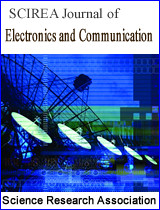Modeling the Effects of Emitter Doping Non-uniformity on the Internal Quantum Efficiency of Si-Drift Solar Cells
DOI: 310 Downloads 3907 Views
Author(s)
Abstract
The introduction of non-uniform doping profile in the quasi-neutral regions of a solar cell helps achieve better performance parameters such as higher conversion efficiency and improved current-voltage characteristics. However, a number of non-ideal effects becomes dominant as the doping level is increased; the transport parameters (i.e. mobility and lifetime) become doping and field dependent, the space-dependency of the bandgap narrowing becomes significant and the Auger recombination mechanism becomes dominant. These effects adversely affect the internal quantum efficiency and hence, need to be considered with great care. Unfortunately, owing to the evolving mathematical intractability, all these effects are not considered simultaneously in the existing models. This work focuses to develop an analytical model for a drift-field Si-solar cell with non-uniformly and heavily doped emitter region where the mathematical intractability problem has been resolved by employing an elegant approximation technique called "Exponential Approximation Technique". The developed model shows that the drift-field solar cells have significantly higher internal quantum efficiency over the uniformly-doped Si-solar cells, particularly for high energy photons.
Keywords
Drift-field solar cell, internal quantum efficiency, non-uniform doping profile
Cite this paper
Md. Yasin Javed Chowdhury, Md. Imrul Basher Chowdhury, Md. Iqbal Bahar Chowdhury,
Modeling the Effects of Emitter Doping Non-uniformity on the Internal Quantum Efficiency of Si-Drift Solar Cells
, SCIREA Journal of Electrics, Communication.
Volume 1, Issue 2, December 2016 | PP. 49-61.
References
| [ 1 ] | M. Wolf, “Drift fields in photovoltaic solar energy converter cells,” Proc. IEEE, vol. 51, no. 5, pp. 674-693, May 1963. |
| [ 2 ] | S. Kaye and G. P. Rolik, “Optimum bulk drift-field thicknesses in solar cells,” IEEE Trans. Electron Devices, vol. 13, no. 7, pp. 563-570, Jul. 1966. |
| [ 3 ] | W. M. Bullis, “Influence of mobility and lifetime variations on drift-field effects in silicon-junction devices,” IEEE Trans. Electron Devices, vol. 14, no. 2, pp. 75-81, Feb. 1967. |
| [ 4 ] | R. V. Overstraeten and W. Nuyts, “Theoretical investigation of the efficiency of drift-field solar cells,” IEEE Trans. Electron Devices, vol. 16, no. 7, pp. 632-641, Jul. 1969. |
| [ 5 ] | F. A. Lindholm and Y. H. Chen, “Current-voltage characteristic for bipolar p-n junction devices with drift fields, including correlation between carrier lifetimes and shallow-impurity concentration,” J. Appl. Phys., vol. 53, no. 12, pp. 8863-8866, Dec. 1982. |
| [ 6 ] | J. A. Del Alemo and R. M. Swanson, “The Physics and Modeling of Heavily Doped Emitters,” IEEE Trans. Electron Devices, vol. 31, no. 12, pp. 1878-1888, Dec. 1984. |
| [ 7 ] | P. A. Basore, D. T. Rover and A. W. Smith, “PC-1D version 2: Enhanced numerical solar cell modeling,” in proc. of 20th IEEE Photovolt. Special Conf., 1988, pp. 389-396. |
| [ 8 ] | L. A.Verhoef and W. C. Sinke, “Minority-carrier transport in nonuniformly doped silicon-an analytical approach,” IEEE Trans. Electron Devices, vol. 37, no. 1, pp. 210-221, Jan. 1990. |
| [ 9 ] | L. A. Verhoef and W. C. Sinke, “New Analytical Expression for Dark Current Calculation of highly doped region in semiconductor,” IEEE Trans. Electron Devices, vol. 44, no. 1, pp. 171-, Jan. 1997. |
| [ 10 ] | M. R. Huqe, S. I. Reba, M. S. Uddin and M. I. B. Chowdhury, “Analytical Modeling of the Base Dark Saturation Current of Drift-Field Solar Cells Considering Auger Recombination,” Int. J. Renew. Energy Res., vol. 3, no. 2, pp. 420-426, 2013. |
| [ 11 ] | D. B. M. Klaassen, J. W. Slotboom and H. C. de Graaff, “Unified apparent bandgap narrowing in n- and p-type Silicon,” Solid-State Electron., vol. 35, no. 2, pp. 125-129, 1992. |
| [ 12 ] | R. J. van Overstraeten, H. J. Deman and R. P. Mertens, “Transport equations in heavy doped silicon,” IEEE Trans. Electron Devices, vol. ED-20, no. 3, pp. 290-298, Mar. 1973. |
| [ 13 ] | M. M. Shahidul Hassan, Orchi Hassan and M. I. B. Chowdhury, “Effect of Majority Carrier Current on the Base Transit Time of a BJT,” Journal of Electron Devices, vol. 10, pp. 511- 514, 2011. |
| [ 14 ] | J. G. Fossum and D. S. Lee, “A physical model for the dependence of carrier lifetime on doping density in nondegenrate silicon,” Solid-State Electron., vol. 25, no. 8, pp. 741-747, 1982. |
| [ 15 ] | J. G. Fossum, “Computer-aided numerical analysis of silicon solar cells”, Solid-State Electron., vol. 19, pp. 269-277, 1976. |
| [ 16 ] | J. Dziewior and W. Schmid, “Auger coefficient for highly doped and highly excited silicon,” Appl. Phys. Lett., vol. 31, no. 5, pp. 346-348, May 1977. |
| [ 17 ] | S. M. Sze, Physics of Semiconductor Devices, 2nd ed., New York, U.S.A.: Wiley, 1981, ch. 14, pp. 800-805. |

